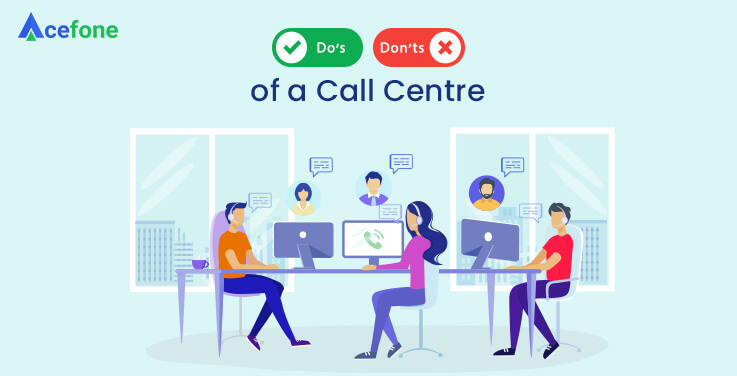The hallmarks of ‘good’ customer service are not limited to the binary question of whether the support agents solved a customer query or not.
“One-third of consumers say they would consider switching companies after just one instance of bad customer service”. Wonder why?
This holistic experience leaves a lasting impression on the customer, and as evident from multiple surveys, it influences their future buying habits and preferences as well.
Therefore, the entire process of taking calls in a call center is a precise art that requires immense practice before perfection.
While taking customer queries might sound like a cakewalk, it isn’t.
The urgency of the support required coupled with the need to ameliorate the consumer’s gnawing anxiety can make the best of agents extremely clammy and nervous.
However, it is crucial to be able to contain this anxiety and skillfully assist the customer.
Call center agents form the first line of communication with the customers—to troubleshoot crises or guide confused customers. Not only this, but they also form the first line of defence against unhappy customers and help them solve their issues
While there is no blueprint for becoming a successful BPO agent, here are some skills that your agents can strive to emulate for excellent customer service.
But before we dive deep into the skills, let us divide each customer call into the following three zones and discuss each zone sequentially along with the corresponding best practices:
1. Pre-call time is the time taken to assign an agent to resolve the query of a caller. It is essentially the wait time for the customer to be allotted to an available agent.
Some companies introduce a voice assistant or a dial-pad-assisted voice chat during the pre-call time to guide the customer with general FAQs or gauge the urgency of the situation.
2. Call time refers to the average time of the conversation between a caller and an agent. It generally consists of issues raised by the customer and resolutions given by the agent.
It is a crucial phase as the customer tends to get irate, and therefore, the agent needs to engage the customer peacefully. The calmer the agent, the more successful the call will be.
3. Post-call time refers to any activity that happens post the customer support call. Some calls are often left with open action points, and therefore, it is essential to close them and revert to the corresponding customer as soon as possible.
Companies can also use this segment to conduct general feedback surveys with customers to determine the quality of the support services provided.
Without further ado, let’s dig deep into the do’s and don’ts for call center agents during each of these phases and learn more about them.
Best in class practices: Call center operations
Good customer service results in happier customers, which effectively means better sales and more retention.
The power of ‘word-of-mouth’ is quite underrated, and so is the effectiveness of good customer service for a company’s success. While a robust system such as a PBX legacy control or cloud solutions is vital for streamlined customer service, the softer aspects of the conversation should also be looked after.
Here are some tips that you must follow to ensure a holistically successful and good customer experience.
#1 Pre-call
-
Reduce the customer waiting time as much as possible
Customers hate waiting—especially when they are in the middle of time-intensive purchases or critical situations. The more you make them stay, the worse their experience gets.
They complain about feelings of frustration and anxiety due to long waiting times. Therefore, you must look into possible solutions that can cut down these long queues.
One such solution is callback solutions (or virtual queuing)! You can simply use it to manage large volumes of incoming calls by providing callback tickets to all the waiting customers.
In this way, customers can utilise their ‘waiting time’ in more productive activities and wait for the agents to call them back as per their sequence index, also assuaging their wait anxiety in the process.
#2 Call time
-
Sound polite and professional while maintaining a friendly approach
It can be unnerving if the customer is greeted by a machine or a cold agent when looking for genuine help. A friendly touch can soothe the customer’s nerves and make the whole process much easier.
Ask your agent to sound enthusiastic whilst maintaining professionalism. Being enthusiastic while solving customer queries is generally perceived positively by the customer, ultimately leading to more comfort. The agent can also discuss the issues and solutions at hand with more confidence closing the deal amicably.
-
Listen closely to your customer and do not interrupt
Customers feel at ease if they believe their problems will be solved by the agent they are talking to. Therefore, it is crucial to understand and employ the art of listening without interrupting your customer. Hearing out the customer properly also ensures the complete exchange of information that would be required to solve the problem completely.
In case things get intense, the agent must deal with the situation calmly instead of counter-retaliating back to the customer in kind. Put simply, the agents’ patience and courtesy are what differentiates a good customer experience from the bad.
-
Possess in-depth knowledge of the company, its products, and services
They say a good call center agent is the one who knows everything about the company and its operations.
However, no agent can have the answer to all customer queries. Tackling them with confidence and grace is what makes your agent an excellent customer service rep.
Give your agent a thorough understanding of your company. They must know how to use the company’s calling system to manage calls, transfer or put them on hold while dealing with multiple stakeholders simultaneously.
A little tutorial to your agents can result in them working exceptionally well with customers and other employees. Customers will also be imbued with a sense of security if the agent handling them radiates the same through his workflow.
#3 Post-call
-
Honour your commitments and value customer feedback
Sometimes, the resolution to customer queries requires more than a simple phone call to the concerned department. It might require multiple follow-ups with different people.
Therefore, it is essential to keep the customer in the loop. Keep them updated on the progress of their query.
It only takes a tweet or a social media post for the customer to narrate their inadequate experience with the world.
Ask your customers about the feedback of your services to keep them coming back. It makes them feel valued. Use suggestions and recommendations to deliver a worthwhile experience for your audience. Engage in conversations and know about their experience post the call.
To sum up
Call center agents can either make or break long-lasting customer relationships and, thus, directly influence the success of your operation.
Therefore, it is essential to continually work on the softer aspects of conversational commerce and engage customers in a call center. Following the mentioned tips could be a healthy starting point for you to improve the performance of your call center workforce.
To learn more, get on-call with our cloud experts at 1888-859-0450 or drop an email at [email protected]!














